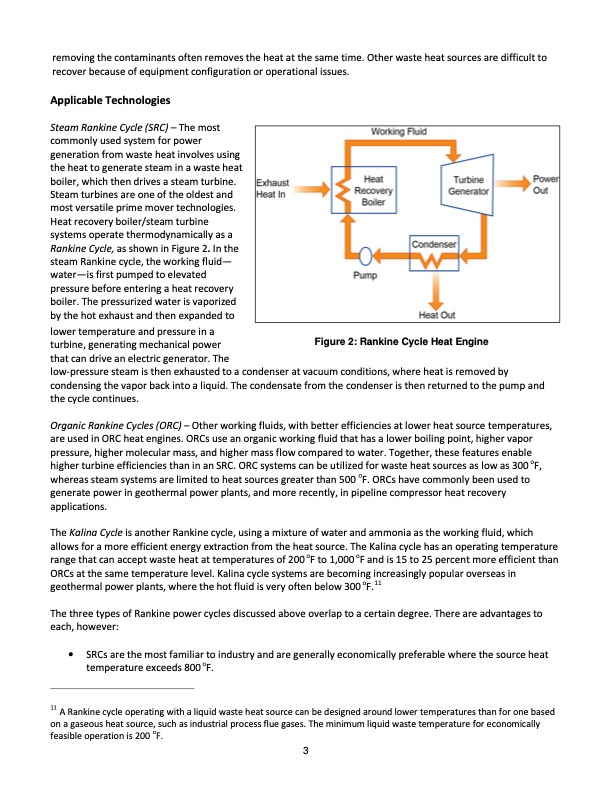
PDF Publication Title:
Text from PDF Page: 003
removing the contaminants often removes the heat at the same time. Other waste heat sources are difficult to recover because of equipment configuration or operational issues. Applicable Technologies Steam Rankine Cycle (SRC) – The most commonly used system for power generation from waste heat involves using the heat to generate steam in a waste heat boiler, which then drives a steam turbine. Steam turbines are one of the oldest and most versatile prime mover technologies. Heat recovery boiler/steam turbine systems operate thermodynamically as a Rankine Cycle, as shown in Figure 2. In the steam Rankine cycle, the working fluid— water—is first pumped to elevated pressure before entering a heat recovery boiler. The pressurized water is vaporized by the hot exhaust and then expanded to lower temperature and pressure in a turbine, generating mechanical power that can drive an electric generator. The low-pressure steam is then exhausted to a condenser at vacuum conditions, where heat is removed by condensing the vapor back into a liquid. The condensate from the condenser is then returned to the pump and the cycle continues. Organic Rankine Cycles (ORC) – Other working fluids, with better efficiencies at lower heat source temperatures, are used in ORC heat engines. ORCs use an organic working fluid that has a lower boiling point, higher vapor pressure, higher molecular mass, and higher mass flow compared to water. Together, these features enable higher turbine efficiencies than in an SRC. ORC systems can be utilized for waste heat sources as low as 300 oF, whereas steam systems are limited to heat sources greater than 500 oF. ORCs have commonly been used to generate power in geothermal power plants, and more recently, in pipeline compressor heat recovery applications. The Kalina Cycle is another Rankine cycle, using a mixture of water and ammonia as the working fluid, which allows for a more efficient energy extraction from the heat source. The Kalina cycle has an operating temperature range that can accept waste heat at temperatures of 200 oF to 1,000 oF and is 15 to 25 percent more efficient than ORCs at the same temperature level. Kalina cycle systems are becoming increasingly popular overseas in geothermal power plants, where the hot fluid is very often below 300 oF.11 The three types of Rankine power cycles discussed above overlap to a certain degree. There are advantages to each, however: • SRCs are the most familiar to industry and are generally economically preferable where the source heat temperature exceeds 800 oF. 11 A Rankine cycle operating with a liquid waste heat source can be designed around lower temperatures than for one based on a gaseous heat source, such as industrial process flue gases. The minimum liquid waste temperature for economically feasible operation is 200 oF. Figure 2: Rankine Cycle Heat Engine 3PDF Image | waste heat to power systems

PDF Search Title:
waste heat to power systemsOriginal File Name Searched:
waste_heat_to_power_systems.pdfDIY PDF Search: Google It | Yahoo | Bing
NFT (Non Fungible Token): Buy our tech, design, development or system NFT and become part of our tech NFT network... More Info
IT XR Project Redstone NFT Available for Sale: NFT for high tech turbine design with one part 3D printed counter-rotating energy turbine. Be part of the future with this NFT. Can be bought and sold but only one design NFT exists. Royalties go to the developer (Infinity) to keep enhancing design and applications... More Info
Infinity Turbine IT XR Project Redstone Design: NFT for sale... NFT for high tech turbine design with one part 3D printed counter-rotating energy turbine. Includes all rights to this turbine design, including license for Fluid Handling Block I and II for the turbine assembly and housing. The NFT includes the blueprints (cad/cam), revenue streams, and all future development of the IT XR Project Redstone... More Info
Infinity Turbine ROT Radial Outflow Turbine 24 Design and Worldwide Rights: NFT for sale... NFT for the ROT 24 energy turbine. Be part of the future with this NFT. This design can be bought and sold but only one design NFT exists. You may manufacture the unit, or get the revenues from its sale from Infinity Turbine. Royalties go to the developer (Infinity) to keep enhancing design and applications... More Info
Infinity Supercritical CO2 10 Liter Extractor Design and Worldwide Rights: The Infinity Supercritical 10L CO2 extractor is for botanical oil extraction, which is rich in terpenes and can produce shelf ready full spectrum oil. With over 5 years of development, this industry leader mature extractor machine has been sold since 2015 and is part of many profitable businesses. The process can also be used for electrowinning, e-waste recycling, and lithium battery recycling, gold mining electronic wastes, precious metals. CO2 can also be used in a reverse fuel cell with nafion to make a gas-to-liquids fuel, such as methanol, ethanol and butanol or ethylene. Supercritical CO2 has also been used for treating nafion to make it more effective catalyst. This NFT is for the purchase of worldwide rights which includes the design. More Info
NFT (Non Fungible Token): Buy our tech, design, development or system NFT and become part of our tech NFT network... More Info
Infinity Turbine Products: Special for this month, any plans are $10,000 for complete Cad/Cam blueprints. License is for one build. Try before you buy a production license. May pay by Bitcoin or other Crypto. Products Page... More Info
| CONTACT TEL: 608-238-6001 Email: greg@infinityturbine.com | RSS | AMP |